Sunday 13th May 2023
Guidebook: About 12 miles
My Garmin/steps: No idea, but it felt long enough!
It’s a relaxed start to day four of my Walsingham Camino. I enjoy a leisurely breakfast in my cosy cottage accommodation before strolling up the road to Sunday mass at the Catholic church of St Therese of Lisieux in Stansted Mountfitchet. The church looks modern and spacious, built in the style of an East Anglian granary barn. I’m a bit worried about the state of my boots; despite much banging and scraping they are still well-coated with mud from yesterday’s adventures, and I don’t want to make an embarrassing mess on the church carpet. In the end I take off my boots in the porch and go inside in my socks, hoping no one will think me too eccentric.
The church is beautiful inside, full of light, with big, circular murals depicting the resurrection and baptism of Jesus*. Father Liam, the parish priest, is friendly and welcoming. He encourages us all to spend a few minutes in silent meditation at the end of his homily. I reclaim my boots at the end of mass feeling spiritually refreshed, ready for another day on the road.


A pilgrim with time to reflect
Leaving Stansted Mountfitchet, I skirt around woods and across fields, soon re-baptising my boots with a fresh layer of wet mud. It’s not far to the pretty village of Ugley Green where – oh hallelujah! – the sun comes out for the first time on my entire pilgrimage. I pause on a bench beside the green to take off my coat and munch an energy bar before heading across hilltop wheatfields with far-reaching views. The path here is straight and deserted, and I get a real sense of being a pilgrim with time to reflect as I walk. A simple list of prompts for prayer popped up on one of my Facebook groups this morning. It appealed to me, so I screenshot-ed it to my phone, and I turn to it now. It’s headed: Talk to Jesus. So I do, praying simply as I stride along, doing my best to share my hopes, struggles and blessings with God.
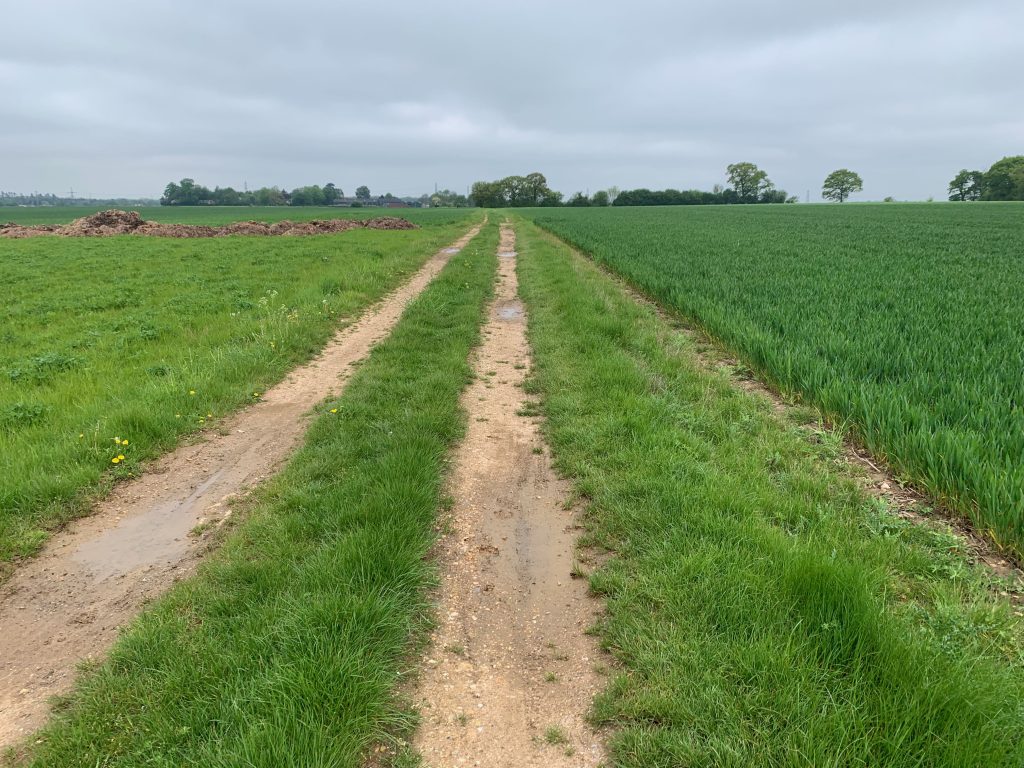
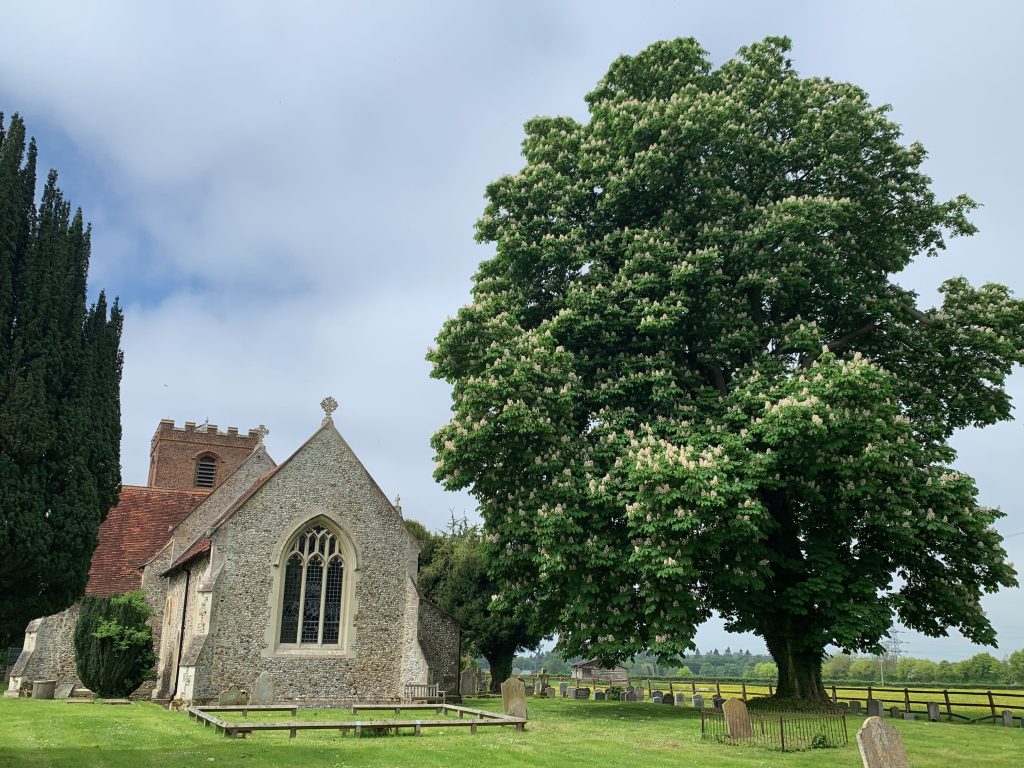

A motorway and a river
My guidebook says there’s a church at Ugley with a pilgrim stamp in the porch. I’d have missed it altogether without the book, as the little church of Saint Peter is tucked away behind a farmyard. A woman at the farm directs me past the next barn and up a little track. The old flint building seems dwarfed by the huge horse chestnut tree in full bloom which stands beside it. It makes a classic English rural scene.
I peep inside the church building, but there are several people chatting at what must be the end of a Sunday service, and I’m too shy to interrupt them to ask about the pilgrim stamp. I return through the grassy churchyard and head down the hill, passing fields full of sheep and lambs on my way towards the M11 motorway.
There’s a big tunnel under the motorway. I’ve driven up and down the M11 countless times without ever realising what delightful countryside nestles so close beside the thundering thoroughfare. The hedgerows are frothy with cow parsley and the white hawthorn blossom my grandmother used to call ‘May’. I soon meet the infant River Cam on its way, like the M11, to Cambridge. The Cam is little more than a trickle here, but seeing it brings back happy memories of family days in and around the university city on punts and paddleboards.
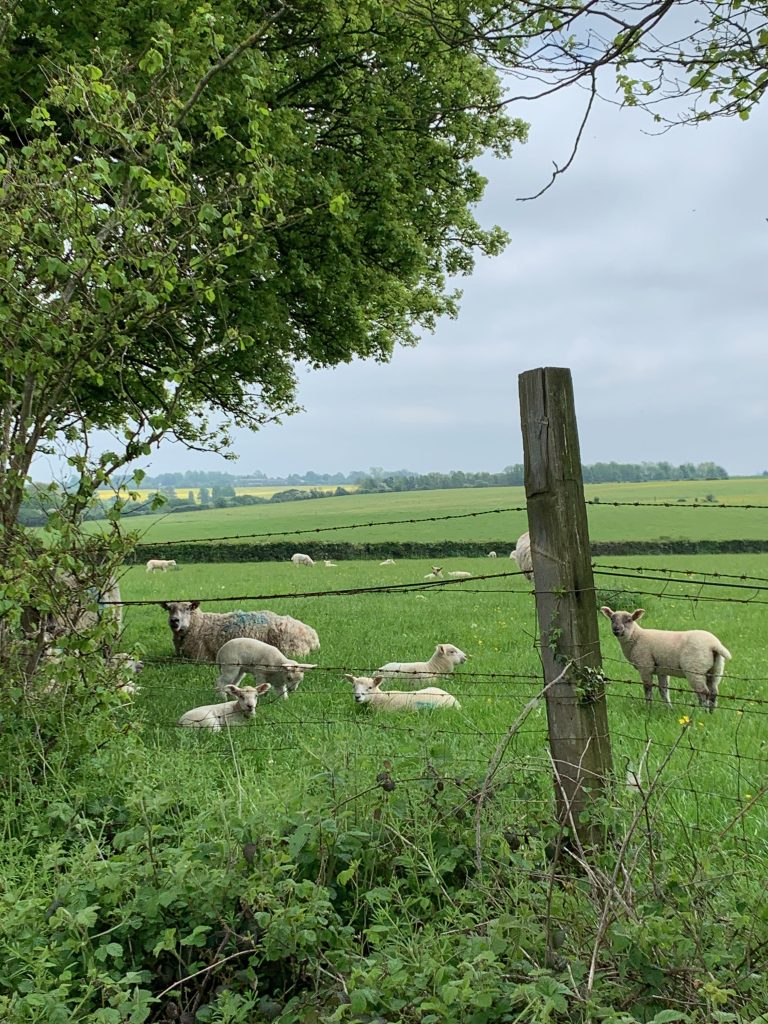

Chalkland and crocuses
Soon I’m walking uphill again, noticing orange tip butterflies that I’ve scarcely seen since my childhood. There are blue butterflies too, and wild geraniums, lady’s bedstraw, and yellow daisies. Something about the gentle roll of these hills feels familiar, though I’ve never walked through this north-west corner of Essex before. It comes to me as I gaze up across the fields towards a curve of woodland: this is chalkland. I grew up on the edge of the Chiltern Hills and close to the Berkshire Downs. When I think of the English countryside, I instinctively imagine a scene like this. Chalkland feels like home.
I pause to enjoy the picture-perfect hamlet of Little Henham, where chickens peck in a barn, apple blossom adorns the trees, and houses overlook a pond with green watercress and golden kingcups. Then it’s uphill through woodland, where I join the Saffron Trail, a long distance path traversing Essex diagonally from Southend in the southeast to Saffron Walden in the north-west.
This route is marked with mauve crocus flower roundels – a reminder of the lucrative saffron trade which gave Saffron Walden its name. The crocuses, from whose golden stamens saffron is made, thrive on chalky soils, and were grown extensively in this area from the fourteenth century until the eighteenth, when cheaper foreign imports put the locals out of business*.

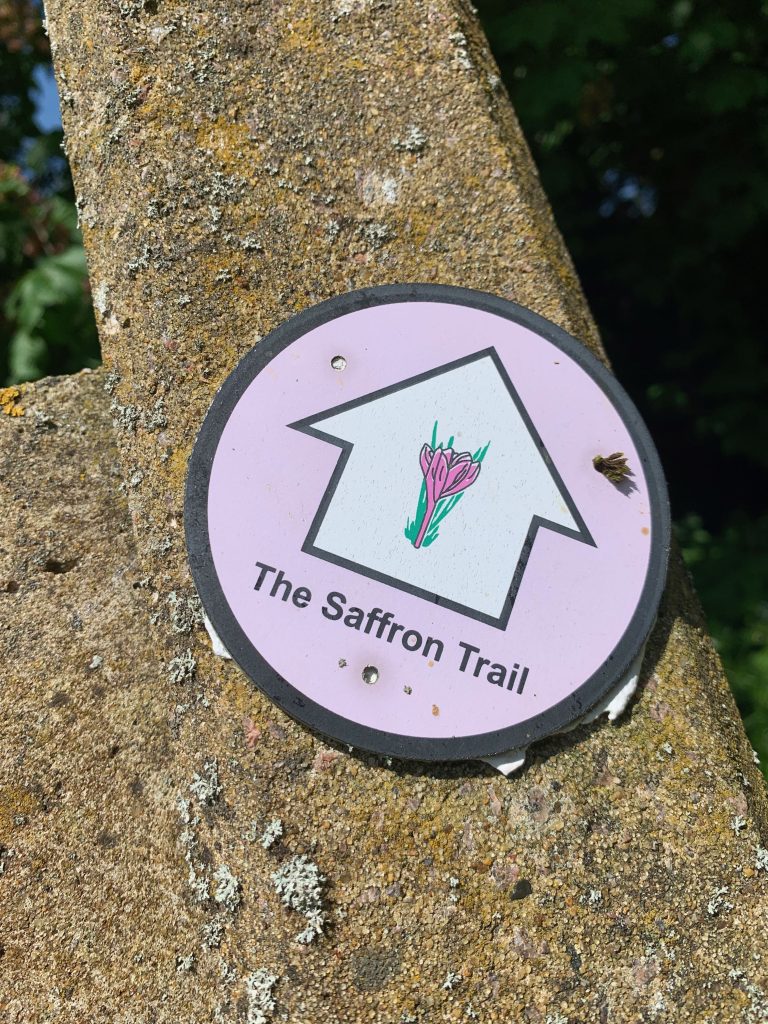
Fish, chips, and four hundred oak trees
Having complained about the gloomy clouds, I am already finding the sun rather too hot for comfort. I must be a true Englishwoman, never satisfied with the weather! Still, it’s warm enough to sit outside in the delightful garden of the Fleur-de-Lys pub in Widdington, where I tuck into fish and chips, washed down with a pint of cider. The landlord is friendly, asking about my pilgrimage, and offering me water to refill my bottle, and sun cream for protection on my journey. I linger over rhubarb crumble and coffee, and it’s a bit of an effort to get up and urge myself onwards.
I’ve spotted a reference on my map to Prior’s Hall Barn, managed by English Heritage, nearby in Widdington. It sounds suitably medieval, and, although I’m feeling rather heavy after my greedy lunch, I decide to make the effort to find it. It’s well worth it.
Just around the next bend in the road, and up a farm track, stands a glorious East Anglian barn, constructed in the fourteenth or fifteenth century from four hundred oak trees. I have the place to myself, and it has the magnificence of a vast church or cathedral. The modern Catholic church in Stansted Mountfitchet, so spacious and airy, was modelled on buildings like this.
I’ve seen plenty of wheat growing in the fields on my walk today, and this barn was constructed to store cereal crops grown in the area centuries ago. There are doors to allow access for cats and owls to control vermin, wide doors for carts, and a raised floor at one end for drying grain.
Widdington once belonged to the wealthy Bishop of Winchester, William of Wykeham, who founded New College, Oxford. Prior’s Hall Barn was constructed to store the college’s cereal riches. I’m reminded of Jesus’s parable about the man who built new and bigger barns to ensure his material security but forgot to be ‘rich toward God.’*. The barn is wonderful, but its contents are long gone; I pray that my pilgrimage will help me journey towards values that last.

Fellow pilgrims on the Walsingham Camino
I pass the church of Saint Mary on my way out of Widdington and am heartened to see a sign in the porch welcoming London to Walsingham Camino pilgrims with an offer of free water and use of the church’s toilet. The people of Widdington seem a hospitable bunch.
Signing the church visitor’s book, I see I’ve been preceded here by a fellow pilgrim on the 9th of May, and also by Andy Bull, author of the Camino guidebook, and his companions on the 14th of April this year. The sense of fellowship in a shared endeavour is inspiring. I feel quite privileged to be undertaking this pilgrimage in its first year and hope my experiences will be an encouragement to others.
Traversing elevated and dusty wheatfields, I begin to feel weary. That cider, and the rhubarb crumble, might have been a mistake, but mostly I’m tired from yesterday. I’ve done long distance hikes before, but I’ve usually spent a whole week’s holiday walking consecutively for six or seven days. On those trips I’ve always found day two to be the toughest, when my body is complaining from the unaccustomed exertions of day one but hasn’t yet got into the swing of walking every day.
It strikes me now that one of the challenges of walking to Walsingham over a series of separate weekends will be that every other day will be a ‘day two’. My hips are aching, and my feet feel sore, as I come downhill again, passing chalk quarries, and crossing the railway line into the next settlement of Newport.

Newport: medieval art and energy drinks
Newport’s a charming little town with medieval cottages lining the main street. I spot a glorious half-timbered house called Monk’s Barn, with a very old carving of Our Lady below an oriel window. Mary is holding the infant Jesus and what looks like a triple-flowered lily. She is flanked by angels playing musical instruments and reminds me very much of the representations of Our Lady of Walsingham. The house dates back to the fifteenth century, and I imagine the pilgrims in times long ago passing her on their journey.
The church of Saint Mary the Virgin in Newport is described in my guidebook as a ‘treasurehouse’. I take a look inside and find the painted twelfth century chest believed to be the earliest painting on wood known to British art but realise I’m too tired to care very much right now. A bench outside in the churchyard and a welcome energy drink gives me the opportunity to plan my next steps.
The official route takes me back across the railway line and up the hills again towards Audley End and Saffron Walden. But I’m planning to finish today at Audley End station, which I now see is a good mile or more to the west of Audley End House. It’s already gone four o’clock, so I make the decision to take a more direct route, staying on this side of the railway and heading straight for the village of Wendens Ambo which is close to the station.
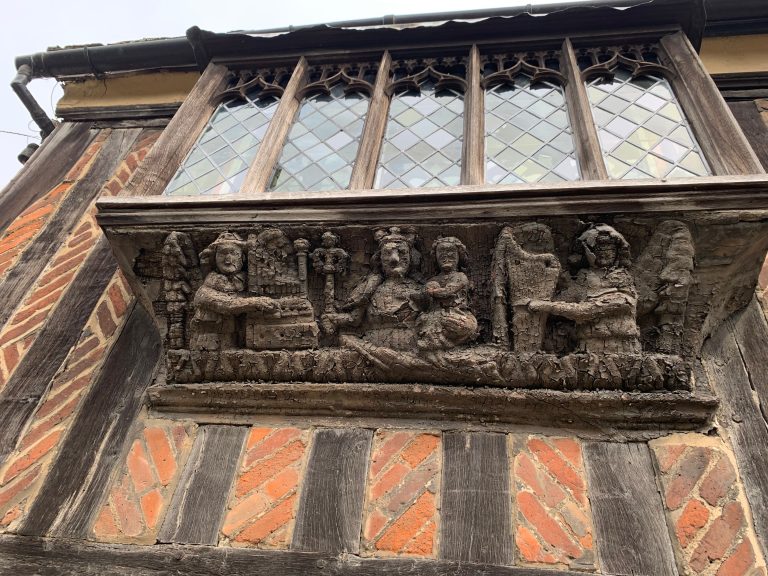
Holey stones and heading homeward
On my way out of Newport I notice a house with a display of stones with holes, sometimes known as hagstones or adder stones, hanging on strings outside the wide porch. There are so many I wonder if the porch is strong enough to bear the weight. As a keen collector of ‘holey stones’, as I like to call them, I am suitably impressed, and pause to congratulate the owner of the house, who happens to be getting into her car as I am passing.
She tells me the stones all come from Southwold beach, where she has often visited with family. I’m very fond of Southwold myself and walked the whole Suffolk coast path with hubby Adrian last year, so feel a pleasing sense of connection. I wouldn’t have seen the holey stones if I’d stayed on the ‘official’ path.
It’s a pleasant enough mile or two across farmland to Audley End station, but all I really want now is to get home. I’m overheated, dehydrated, and mentally drained. At the station I sit inside in the shade to wait for the next train, downing another energy drink. I get to Bishop’s Stortford easily enough, but after this I endure a torturous and baking-hot succession of rail replacement buses before finally arriving back at Stanstead St Margaret and my car at around seven pm. The trials of public transport on a Sunday! I almost feel it would have been easier to have walked back.
The next stages of my pilgrimage will take me into the remoter parts of Suffolk, beyond easy reach of railway stations, so I will have to plan my travels creatively. For now, I’m happy to be on my way home to family and a long, relaxing soak in the bath. Next time, Saffron Walden and beyond…

Karen Lawrence is a mother, grandmother, yoga teacher and writer. She lives with husband Adrian and youngest daughter Martha in Billericay, Essex, United Kingdom. Karen has published two books and is currently working on a novel about outlaw midwives in a dystopian future Britain.
Letting the Light In: How A Baby With Down Syndrome Changed My Life is Karen’s personal account of having a baby with Down Syndrome. It is available from Amazon at
Karen’s first book, Finding Your Calm Space: Thirty-One Ways to find Calm in a Crazy World is available from Amazon at
If you would like to follow Karen and be kept up to date with her writing, please sign up at https://karenlawrenceauthor.com/join-the-mailing-list/
Further Reading
Why am I walking to Walsingham? You can read more about the Walsingham Camino at my blog.
London to Walsingham Camino: Walsingham? Where’s that?
Learn more about the lovely church of St Therese in Stansted Mountfitchet here
https://taking-stock.org.uk/building/stansted-st-theresa-of-lisieux/
Saffron Walden and the Saffron Trail
https://ldwa.org.uk/ldp/members/show_path.php?path_name=Saffron+Trail
Prior’s Hall Barn
https://www.english-heritage.org.uk/visit/places/priors-hall-barn/history/
Jesus’s Parable about the rich man and his barns: https://www.biblegateway.com/passage/?search=Luke+12%3A13-21&version=NIV
Monk’s Barn in Newport:
https://britishlistedbuildings.co.uk/101234841-monks-barn-newport
Andy Bull’s Guidebook for the London to Walsingham Camino can be found here:




